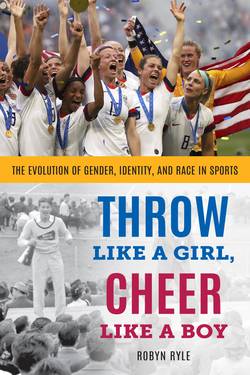Читать книгу Throw Like a Girl, Cheer Like a Boy - Robyn Ryle - Страница 25
На сайте Литреса книга снята с продажи.
What’s the “Sex” in Sex Hormones?
ОглавлениеWhat is testosterone, anyway? Testosterone is a hormone, and hormones are essentially messengers in the chemical communication system in our bodies. They’re released by glands or cells in one part of the body and carry instructions to the rest of the body. Testosterone is a kind of androgen and, along with estrogen, these are often referred to as sex hormones, even though both androgen and estrogen have many effects in our bodies that have nothing to do with reproduction or other biological markers of sex. Androgen, the “male hormone,” is present in women’s bodies, and testosterone specifically is crucial for well-being in both women and men because it contributes to heart, brain, and liver function, among other things.[22] Likewise, estrogen is in men’s bodies and, even though it’s a “female hormone,” it can have masculinizing effects. For example, some studies have shown an association between estrogen and dominant behavior in women. Estrogen and testosterone sometimes perform identical functions.[23] As feminist biologist Anne Fausto-Sterling has pointed out, it would probably make more sense to call estrogen and androgen “growth hormones” as opposed to “sex hormones.”[24]
Testosterone may not be a sex hormone, but does it still provide a competitive advantage for female athletes? As far as current research tells us, the answer is no. There is no evidence that successful athletes have higher testosterone levels than less successful athletes.[25] Studies do tell us that testosterone (in concert with many other factors) can help individuals increase their muscle size, strength, and endurance.[26] All of that seems to imply that testosterone would confer a competitive advantage, but the reality is more complicated. For example, women with complete androgen insensitivity syndrome (CAIS) are unable to process testosterone, which means the testosterone in their body has no effect on their musculature or endurance. Yet, women with CAIS are overrepresented among elite athletes, with some estimates suggesting one in five hundred female athletes are affected by CAIS.[27] That women who can’t process testosterone are more likely to be elite athletes doesn’t match with the argument that testosterone increases athletic ability. Additionally, women with congenital adrenal hyperplasia (CAH) have elevated levels of testosterone and therefore should have a competitive advantage. But women with CAH are more likely to have shorter stature, suffer from obesity, and face unpredictable, life-threatening crises due to loss of salt in their bodies.[28] These effects hardly seem compatible with success as an elite athlete.
The truth is that any single person is likely to have a very different reaction to the same amount of testosterone, and testosterone is just one element in a complex system of communication between hormones and our bodily processes. On top of that, competition itself, and especially winning, increases the level of testosterone in our bodies. This is true even for fans watching a game, or experimental subjects who are randomly assigned as winners. In fact, studies suggest that the relationship between testosterone and competitiveness might be the exact opposite of what we expect. In both male and female athletes, levels of testosterone in their bodies rise before a competition. The social situation of standing at the starting line has a biological effect in the form of increased testosterone. This finding is part of a growing body of research demonstrating that our hormones might be driven as much by social contexts as they are by biology.[29]
